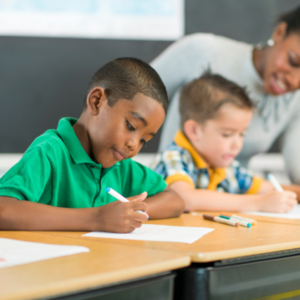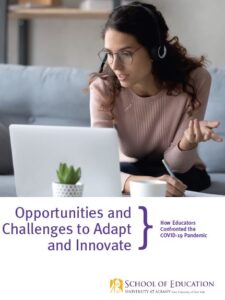Meeting the Needs of Students with Disabilities: Challenges and Promising Practices from NYKids Research
by Jessie Tobin and Kristen C. Wilcox
In 2022, the National Assessment of Educational Progress (NAEP) published data on youth reading assessments showing a dip in test scores among nine-year-old students. These data were especially alarming for students with disabilities (SWDs). Much of the lag in learning progress for SWDs has been attributed to the disruptions that resulted from remote and hybrid learning during the pandemic.
In a survey conducted through the American Institutes for Research (AIR), educators reported the challenges they have faced in meeting the needs of their students with IEPs (Individualized Education Programs). The Individuals with Disabilities Education Act (IDEA) protects the rights of students with disabilities and was signed into law in 2004. The rights outlined in IDEA assure that SWDs are consistently provided with appropriate accommodations and supports for learning per their IEPs, which must continuously be evaluated by practicing professionals. Additionally, IDEA mandates that all students with disabilities are educated in the “least restrictive environment possible.” Educators and school leaders felt the pressures of adhering to these federal requirements as they adapted to pandemic-related burdens and stress.

Challenges of Meeting the Needs of Students with Disabilities
According to the survey conducted by AIR, educators and school leaders reported experiencing significant challenges in meeting the requirements of IDEA during the time of remote instruction. Districts with higher numbers of economically disadvantaged youth, in particular, experienced greater setbacks to meeting students’ needs when it came to establishing IEP goals and facilitating IEP meetings. Regardless of level of economic disadvantage, school districts reported experiencing difficulties regarding family and caregiver engagement, community agency collaboration, and providing instructional supports as outlined by IDEA to meet the needs of students with disabilities as required by law.
Challenges and Promising Practices from NYKids’ COVID-19 Educator Response Study
The educator responses captured in the AIR survey are consistent with the data from NYKids’ COVID-19 educator response study. In 2021, NYKids conducted a study investigating New York State educators’ experiences during the pandemic. We found that educators found it difficult to meet the different academic and social-emotional needs of their students. Support staff and teachers were worried about student engagement and participation in class, with special concern for students with special needs.
- Maintaining Supports Through Virtual Instruction
In one school in our study, educators reported challenges to providing necessary supports for students with special needs as they often did not consistently submit work during remote instruction. In this instance, the school counselor, social worker, and special education teacher would frequently work together to find ways to provide consistent instruction to students even if it meant creating independent lessons for the student via videoconference in the presence of the counselor and social worker. As one educator explained,
“We did, another thing … as far as supporting our kids— all of our student support services, were continued to provide those supports virtually. So students were still getting speech. They were still meeting with our social worker, our reading specialists were teaching reading to our AIS students virtually.”
- Maintaining Communications with Parents and Caregivers
Educators in our study also reported increasing their communication and online meetings with parents to discuss particular instructional goals and requirements for these students. Educators called upon parents and caregivers to help support children’s learning and this was not an easy or desirable method as one educator explained,
“What we did was we worked with the families, and the parents, we said to them ‘meet us at such and such a time, and we’re going to tell you what you need to do with your kids,’ is what we did. And we had self-contained going out to the kids’ homes and working in driveways, after a while… Never again, in history will we have a shutdown in which special ed kids, particularly self-contained, are not in the building, because it doesn’t work.”

- Developing and Using New Methods to Monitor Need and Progress
Educators from another school in our study specifically commented on the challenges of identifying students with special needs and implementing school-based interventions as required under IDEA. One staff member pointed to the struggles their evaluation team experienced while using assessments which were developed prior to the pandemic:
“They’re not normed for this huge crisis that we’ve all faced. So we’re using norms based on average exposure to the curriculum and everything, but they [students] haven’t had that.”
AIR Recommendations for Adapting to Shifts and Educating Youth with Disabilities Post-Pandemic
Despite the difficulties experienced by educators across the board during remote and hybrid instruction, educators and school leaders have begun to adapt to pandemic shifts and plan to serve students with special needs even better. AIR provides key takeaways:
- Continue to adopt flexible intervention programs that focus on the individual needs of children and multi-tiered supports
- Increase one-on-one time between students and instructors, as well as communication between educators and parents, to address continued challenges such as learning gaps
- Utilize technology to increase students’ consistent access to a variety of therapies (i.e., occupational therapy), which can be provided to students at home via online services
Be sure to check out NYKids’ latest projects in partnership with AIR as we collaborate to address problems of practice in the pandemic-recovery era.
Thank you for your interest in NYKids. You may visit our webpage for the latest research and news, and follow us on Twitter, Instagram, or Facebook, for announcements.
